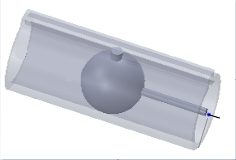Indice
An introductory rollbar-like structure
maxima worksheet, starting point
maxima worksheet, as at the end of the lesson
test_repeated_evals_not_working_as_expected_by_bertocchi.wxmx
[skew-]Symmetry in structures
Symmetric and skew-symmetric loading conditions are mostly relevant for linearly-behaving systems; a nonlinear system may develop an asymmetric response to symmetric loading (e.g. column buckling).
The $\ast$ (generalized) displacement components may induce material discontinuity at points laying on the [skew-]symmetry plane, if nonzero. They have to be constrained to zero value at those points, thus introducing [skew-]symmetry constraints.
These constraints act in place of the portion of the structure that is omitted from our model, since the results for the whole structure may be derived from the modeled portion alone, due to [skew-]symmetry.
In case of symmetry, a constraint equivalent to a planar joint is to be applied at points laying on the symmetry plane for ensuring displacement/rotation continuity between the modeled portion of the structure, and its image. In case of skew-symmetry, a constraint equivalent to a sphere [with dowel] - slotted cylinder joint, where the guide axis is orthogonal to the skew-symmetry plane, is applied at the points belonging to the intersection between the deformable body and the plane.
The $\diamond$ internal action components are null at points pertaining to the [skew-]symmetry plane, since they would otherwise violate the action-reaction law. The complementary $\dagger$ internal action components are generally nonzero at the [skew-]symmetry plate.
The $\dagger$ external action components are not allowed at points along the [skew-]symmetry plane; instead, the complementary $\diamond$ generalized force components are allowed, if they are due to external actions.
In the case of a symmetric structure, generally asymmetric applied loads may be decomposed in a symmetric part and in a skew-symmetric part; the problem may be solved by employing a half structure model for both the loadcases; the results may finally be superposed since the system is assumed linear.
Conceptually similar to [skew-]symmetry constraints are the periodicity constraints, which will be detailed if needed.
Castigliano's second theorem
Castigliano's second theorem may be employed for calculating deflections and rotations, and it states:
If the strain energy of an elastic structure can be expressed as a function of generalised loads $Q_i$ (namely, forces or moments) then the partial derivative of the strain energy with respect to generalised forces supplies the generalised displacement $Q_i$ (namely displacements and rotations with respect to which the generalized forces work).
In equation form, $$ q_{i}= \frac {\partial U}{\partial Q_{i}} $$
where $U$ is the strain energy.
Internal energy for the spatial straight beam
The linear density of the elastic potential (alternatively named internal) energy for the spatial rectilinear beam may be derived as a function of its cross section resultants, namely
$$ \frac{dU}{dl} = \frac{ J_{yy} M_{x}^2 + J_{xx} M_{y}^2 + 2 J_{xy} M_{x} M_{y} } {2E\left( J_{xx} J_{yy} - J_{xy}^2 \right)} +\frac{N^2}{2EA} +\frac{ \chi_{x} S_x^2 + \chi_{y} S_y^2 + \chi_{xy} S_y S_x } {2GA} +\frac{M_t^2}{2G K_t} $$
where
- $A$, $J_{yy}$, $J_{xx}$ and $J_{xy}$ are the section area and moments of inertia, respectively;
- $K_t$ is the section torsional stiffness (not generally equivalent to the polar moment of inertia);
- $E$ and $G$ are the material Young Modulus and Shear Modulus, respectively; the material is assumed homogeneous, isotropic and linearly elastic.
The shear energy normalized coefficients $\chi_{y}$,$\chi_{x}$,$\chi_{xy}$ are specific to the cross section geometry, and may be evalated by comparing the actual shear strain energy due to concurrent action of the $S_y,S_x$ shear force components, and the three strain energy nominal counterparts $$ \frac {S_y^2}{2GA},\quad \frac {S_x^2}{2GA},\quad \frac {S_y S_x}{2GA} $$


